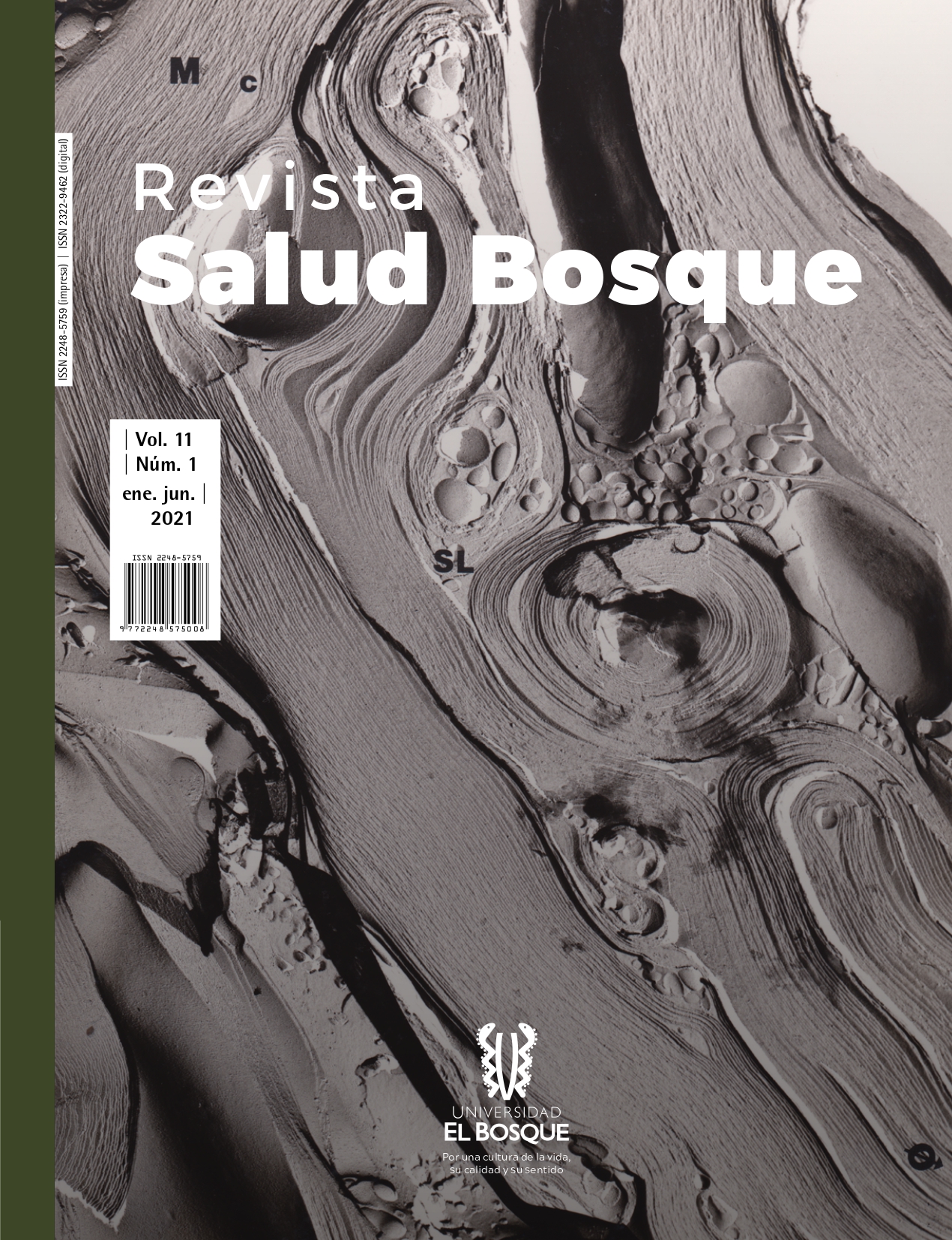Rapid review
physiological changes during aerobic exercise with facemask
DOI:
https://doi.org/10.18270/rsb.v11i1.3504Keywords:
Mask, Aerobic exercise, Adult, Heart rate, Respiratory rate, Oxygen saturation, CO2 concentrationAbstract
Aim: To identify the physiological changes during aerobic exercise with masks in adults. Material and methods: an adaptation of the Cochrane rapid review methodology was used. The search was made on Pubmed, EMBASE, and Scopus, using the terms "mask," "vital sign," and "aerobic exercise." Experimental studies, in adults and with aerobic exercise were included. Results: 331 articles were found, 12 were selected. Surgical mask and N95 were evaluated in three and six investigations respectively. During low intensity exercise with a mask, increases in heart and respiratory rate, temperature and CO2 concentration were observed, being slight changes and without clinical importance. Perception of effort was unchanged. No studies with moderate or high intensity interventions were found. Conclusion: the use of face masks slightly increases some physiological variables without clinical relevance during low intensity exercise. Future research should evaluate physiological changes during moderate and high intensity exercise.
Downloads
References
Cintra O; Navarro Y. La actividad física: un aporte para la salud. Educación Física y Deportes, Revista Digital. Buenos Aires, Año 16, Nº 159, Agosto de 2011.
Feng Y, Yang S, Tan Z, Wang M, Xing Y, Dong F, et al. The benefits and mechanisms of exercise training for Parkinson's disease. Life Sciences 2020 March 15,;245:117345.
Cooper SB, Bandelow S, Nute ML, Dring KJ, Stannard RL, Morris JG, et al. Sprint-based exercise and cognitive function in adolescents. Preventive Medicine Reports 2016;4:155-161.
Brellenthin AG, Lanningham-Foster LM, Kohut ML, Li Y, Church TS, Blair SN, et al. Comparison of the Cardiovascular Benefits of Resistance, Aerobic, and Combined Exercise (CardioRACE): Rationale, design, and methods. American Heart Journal 2019 Nov;217:101-111.
Karssemeijer EGA, Aaronson JA, Bossers WJ, Smits T, Rikkert, Marcel G. M. Olde, Kessels RPC. Positive effects of combined cognitive and physical exercise training on cognitive function in older adults with mild cognitive impairment or dementia: A meta-analysis. Ageing Research Reviews 2017;40:75-83.
Yan Z. Extracellular superoxide dismutase, a molecular transducer of health benefits of exercise. Redox Biology 2020;32:101508.
Upregulation of IL-4 signaling contributes to aerobic exercise-induced insulin sensitivity. Biochemical and Biophysical Research Communications 2020;525(3):662-667.
Langrish JP, Li X, Wang S, et al. Reducing personal exposure to particulate air pollution improves cardiovascular health in patients with coronary heart disease. Environ Health Perspect. 2012;120(3):367-372. doi:10.1289/ehp.1103898
Ramírez P, Nuvials X, Díaz E. Introducción. Medicina Intensiva 2019;43:1.
Dixit S. Can moderate intensity aerobic exercise be an effective and valuable therapy in preventing and controlling the pandemic of COVID-19? Elsevier Enhanced Reader. 2020.
Pifarré F, Zabala DD, Grazioli G, Maura, Ignasi de Yzaguirre i. COVID-19 and mask in sports. Apunts Sports Medicine 2020 Jun.
Chandrasekaran B, Fernandes S. Medical hypotheses 1975;144:110002
Bharatendu C, Jonathan J, Goh Y, Tang J et al. Powered Air Purifying Respirator (PAPR) restores the N95 face mask induced cerebral hemodynamic alterations among Healthcare Workers during COVID-19 Outbreak PPE related cerebral hemodynamic changes. Journal of the Neurological 2020.
Hui DS, Chow BK, Chu L, et al. Exhaled air dispersion during coughing with and without wearing a surgical or N95 mask. PLoS One. 2012;7(12):e50845. doi:10.1371/journal.pone.0050845
Matusiak Ł, Szepietowska M, Krajewski PK, Białynicki-Birula R, Szepietowski JC. The use of face masks during the COVID-19 pandemic in Poland: A survey study of 2315 young adults [published online ahead of print, 2020 Jun 29]. Dermatol Ther. 2020;e13909. doi:10.1111/dth.13909
Sakushima K, Yoshikawa M, Osaki T, Miyamoto N, Hashimoto T. Moderate hypoxia promotes skeletal muscle cell growth and hypertrophy in C2C12 cells. Biochemical and Biophysical Research Communications 2020 May 14,;525(4):921-927.
Walker D, Farquharson F, Klenze H, Walterspacher S, Storz L et al. Diaphragmatic fatigue during inspiratory muscle loading in normoxia and hypoxia. Respiratory Physiology & Neurobiology 2016 /06/15;227:1-8.
Roberge R. Absence of consequential changes in physiological, thermal and subjective responses from wearing a surgical mask; 2012.
Scheid J; Lupien S; West S et al. Commentary: Physiological and Psychological Impact of Face Mask Usage during the COVID-19 Pandemic.2020.
Garritty C, Gartlehner G, Nussbaumer-Streit B, King VJ, Hamel C, Kamel C, Affengruber L, Stevens A. Cochrane Rapid Reviews Methods Group offers evidence-informed guidance to conduct rapid reviews. J Clin Epidemiol. 2020 Oct 15;130:13-22. doi: 10.1016/j.jclinepi.2020.10.007. Epub ahead of print. PMID: 33068715; PMCID: PMC7557165.
Wong AY, Ling SK, Louie LH, Law GY, So RC, Lee DC, et al. Impact of the COVID-19 pandemic on sports and exercise. Asia-Pacific journal of sports medicine, arthroscopy, rehabilitation and technology 2020 Oct;22:39-44.
Person E, Lemercier C, Royer A, Reychler G. Effet du port d’un masque de soins lors d’un test de marche de six minutes chez des sujets sains. Revue des maladies respiratoires 2018 Mar;35(3):264-268.
(23) Vieira JL, Guimaraes GV, de Andre PA, Cruz FD, Saldiva PHN, Bocchi EA. Respiratory Filter Reduces the Cardiovascular Effects Associated With Diesel Exhaust Exposure. JACC. Heart failure 2016;4(1):55-64.
Sellers J, Monaghan T, Schnaiter J, Jacobson B, Pope Z. Efficacy of a Ventilatory Training Mask to Improve Anaerobic and Aerobic Capacity in Reserve Officersʼ Training Corps Cadets. Journal of strength and conditioning research 2016 Apr;30(4):1155-1160.
Vieira JL, Guimaraes GV, de Andre PA, Saldiva PHN, Bocchi EA. Effects of reducing exposure to air pollution on submaximal cardiopulmonary test in patients with heart failure: Analysis of the randomized, double-blind and controlled FILTER-HF trial. International journal of cardiology 2015;215:92-97.
Kim J, Wu T, Powell JB, Roberge R. Physiologic and fit factor profiles of N95 and P100 filtering facepiece respirators for use in hot, humid environments. American journal of infection control 2016;44(2):194-198.
Kim J, Roberge RJ, Powell JB, Shaffer RE, Ylitalo CM, Sebastian JM. Pressure drop of filtering facepiece respirators: How low should we go? International journal of occupational medicine and environmental health 2015;28(1):71-80.
Roberge R Kim J, Powell JB. N95 respirator use during advanced pregnancy. American journal of infection control 2014;42(10):1097-1100.
Roberge RJ, Kim J, Powell JB, Shaffer RE, Ylitalo CM, Sebastian JM. Impact of Low Filter Resistances on Subjective and Physiological Responses to Filtering Facepiece Respirators. PloS one 2013;8(12):e84901.
Kim J, Benson SM, Roberge R. Pulmonary and heart rate responses to wearing N95 filtering facepiece respirators. American journal of infection control 2013;41(1):24-27.
Roberge R, Benson S, Kim J. Thermal Burden of N95 Filtering Facepiece Respirators. The Annals of occupational hygiene 2012 Aug;56(7):808-814.
Epstein D, Zuckermann R. Return to training in the COVID-19 era: The physiological effects of face masks during exercise. Scandinavian journal of medicine & science in sports 2020 Sep 24,.
Wagner DR, Clark NW. Similar results for face mask versus mouthpiece during incremental exercise to exhaustion. Journal of sports sciences 2016 May 2,;34(9):852-855.
Fikenzer S, Uhe T, Lavall D, Rudolph U, Falz R, Busse M, et al. Effects of surgical and FFP2/N95 face masks on cardiopulmonary exercise capacity. Clinical research in cardiology 2020 Jul 6,:1-9.
Scarano A, Inchingolo F, Lorusso F. Facial Skin Temperature and Discomfort When Wearing Protective Face Masks: Thermal Infrared Imaging Evaluation and Hands Moving the Mask. International journal of environmental research and public health 2020 Jun 27,;17(13):462
Downloads
Published
How to Cite
Issue
Section
License
Copyright (c) 2021 Universidad El Bosque

This work is licensed under a Creative Commons Attribution-NonCommercial 4.0 International License.
The authors will submit a statement attesting to the authenticity of the material, attaching signature and id number. It is also required that they submit a statement surrendering economic rights to El Bosque University










